Well, our lovely throwback hostess, April, has been working on it for the better part of 2018, and finally managed to convince the head office to make December a month of disasters movie, showing the classic ’70s melodramas Earthquake, Towering Inferno, Poseidon’s Adventure and Airport. They dropped out Inferno, tragically, because they don’t like to show a movie on the week between Christmas and New Years. Maybe the attendance is too low to justify the rental but I’m not sure how the finances work at all, given how all-over-the-map attendance is anyway.
The Flower bowed out, as she’s been tired with all her activities this Christmas season—she almost didn’t go to Elf, and is bowing out of Sunday’s presentation of White Christmas—which I think is a shame, since there’d be a mix of reactions to the aging stars like Charlton Heston and Ava Gardener as well as plenty of opinions about ’70s fashion. The Boy and I headed off alone, with me perhaps over-confident as to the entertainment value of the movie.
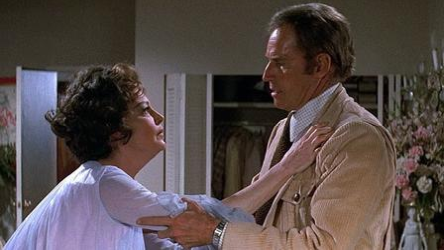
Gardner maybe she’s channeling Gloria Swanson in “Sunset Blvd.”
My concerns were misplaced. If the Irwin Allen movies were not high art, they never pretended to be and they never lost sight of the goal: entertaining the audience. And as is very often the case, done well, that goal transcends generational changes better than many loftier ambitions. Directed by Mark Robson, who directed Humphrey Bogart’s last picture (The Harder They Fall) but who is probably best known for his work on the soapy potboiler Peyton’s Place, Earthquake follows the classic formula of 40-minutes of soap opera followed by disaster followed by your problems don’t seem all that important now, do they?
In this case, we have successful architect Charlton Heston in a dramatically unhappy marriage with Ava Gardner (who seems to be channeling Joan Collins) and being seduced by the queen of hearts herself, Genevieve Bujold. He works for a father-in-law (Lorne Greene) who seems to understand how difficult his own spoiled daughter is, and his secretary (Monica Lewis, who had a boffo music and TV career in the ’50s and became a disaster movie staple in the ’70s) is tight with Genevieve.
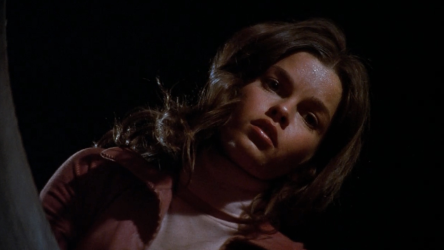
“Looks like it’s not gonna work out, byeeeee!”
Meanwhile, George Kennedy is a cop who puts the job ahead of political concerns: When we meet him, he’s on a reckless high-speed chase that ends with him crashing into Zsa Zsa Gabor’s (not featured) hedge. His explanation—that he witnessed the perp run over a little girl in the car he had just stolen—made me scratch my head a bit. (Like, if the guy never even slowed down, from what vantage point did you witness this, and how was that the same vantage point from which you could have seen the accident and manage to chase the guy. But these details are unimportant.) He gets suspended and ends up in a bar where Walter Matthau (billed with the fake name of Walter Matuschanskayasky) is drinking heavily and a bunch of classic ’70s heavies are arguing over pool.
He meets some old friends/guys he busted there: Daredevil Richard Roundtree (Shaft!) and manager Gabriel Dell (who was one of the original Dead End kids, I believe, and may forever be immortalized as the voice of Boba Fett in “The Star Wars Holiday Christmas Special”). They’re short of cash after being shaken down by the pool hustlers they owe money to, but manage to wheedle $10 out of Kennedy by letting him ogle their official T-shirt, currently tightly pulled over the magnificent chest of Dell’s sister (Victoria Principal).
Principal (whom I didn’t recognize with her ’70s afro) is great in this, actually. It’s a kind of thankless role, where she goes from being ogled, to being solicited by her brother and his friend to stand around and look sexy while he does his motorcycle stunts, to being in a rioting theater, to being arrested for looting (a donut), to being detained and repeatedly nearly raped by Marjoe Gortner.
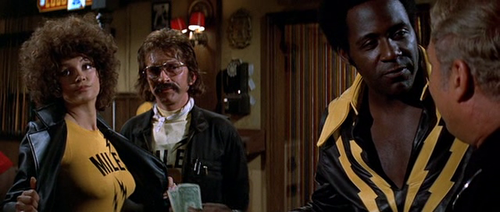
Maybe I wasn’t focused on her face.
Marjoe (forever famous here for Starcrash) is a former serviceman/reserve troop barely repressing his rage while working at a grocery store, and creeping up to Victoria who shops there with insufficient funds. Actually, in a movie that doesn’t trade in as broad stereotypes as you might guess, his character (and Ava Gardner’s) are the cheesiest.
There’s a small army of supporting characters, too, that make up the scientific and political backdrop of the story, and who mostly vanish when the earthquake hits. The Boy and I noticed this: Amongst this crew, there was surprisingly little nonsense and cartoonish behavior. Unfortunately, Jaws (1975) would set the trope for the “authority figures refusing to see reality”, but it’s done much, much better here.
We have a grad student who predicts a small earthquake correctly and using the same ideas predicts the big one—7+, which is nice in a world where your earthquake has to be an impossible 10 or GTFO—but his supervisor (the great character actor Donald Moffat) is reluctant to contact the political mucky-mucks without more proof, for fear of the damage it will do to the office’s credibility. They agree to contact the real brain behind the science, but he’s up in Northern California being murdered by the earthquake while planting seismic activity detection devices. Ultimately, the supervisor goes to the Mayor anyway.

I’m using this still because the other shots of Marjoe are seriously creepy.
The Mayor has a similar problem: He can contact the governor but it’ll cost him politically if he’s wrong—and the mayor isn’t even the same party as the governor (at the time it would’ve been Reagan). Despite his misgivings, he does contact the governor who then mobilizes Marjoe Gortner (and some other guys, too, like another great character actor, George Murdock, as “Colonel”). Meanwhile, up at the dam, there’s a lot of back-and-forth between a guy who’s convinced that the thing is going to go, and his boss who’s pretty sure it isn’t and has to balance the cost of draining the water to prevent a flood and keeping the water available in case of the kinds of shortages and fires that follow an earthquake.
The point is, everyone’s trying, even at personal risk, to minimize the potential damage: They just don’t have any great solutions. Again, unlike the mayor of Amity who simply has to tell people to stay out of the water till they handle the fish ish, this movie portrays a lot of the legitimate trade-offs that come with knowing there might be a disaster. It’s a weird thing to point out, perhaps, that Earthquake (beyond its soap opera story) handles the issue of disaster management more maturely than modern films, but we appreciated that.
Anyway, the earthquake hits and everyone’s in a bad situation. Genevieve has decided to go walking in the canyon, under all the houses on stilts. She’s sent her son off to play in the park, riding over a bridge that was rickety before the earthquake. (And this is why children have never since been let out of the house.) Lorne’s trapped in the skyscraper, while Charleton and Ava are fighting down below. Our daredevil pals are trying to pitch their show when it all falls apart under the shaking. George is in the bar where only Walter Matthau escapes unscathed and complaining about not being able to get a drink.
George and Charlton, being men of action, move around the city doing action-y things. George trying to save lives, Charlton trying to save his squeeze. A good time is had by all.
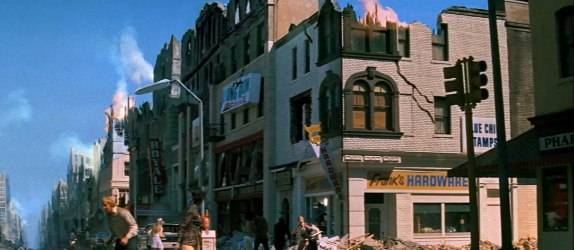
Frank’s Hardware has a hell of a time.
The special effects—well, let’s just say it was the Golden Age of Albert Whitlock, who made matte paintings and other visual effects for The Sting and John Carpenter’s The Thing and a bunch of late era Hitchcock movies, and even has a credit in IMDB going back to Hitch’s 1934 version of The Man Who Knew Too Much. Glorious, glorious mattes as far as the eye can see, most of which still read pretty well. A few of the big-scale models don’t hold up to the current eye, along with some of the “heavy objects” that clearly are cardboard or foam. There is a laughably bad moment where an elevator full of passengers crashing to their deaths is depicted with a large glob of animated blood splatted on the frames.
But mostly they work because they do read well and make the action clear, and a few are still pretty impressive. Over 140 stunt men were involved, and there are moments where you are amazed. Like when Richard Roundtree’s stunt double does the motorcycle loop, he just falls off. It’s, like, a 20 foot drop with the motorcycle landing on top of the guy. Even the run-of-the-mill (for the time) car chases have a degree of danger you don’t tend to feel these days.
The musical score by John Williams lacks the catchy themes he would be known for later, but it’s actually a pretty nice piece of work. It combines elements of orchestral bombast, ’70s TV-cop-drama brass (though without getting obnoxious as those scores often did), and even some elements of horror.
At 2 hours and 9 minutes, we were not bored. It was a fun experience, and one I would recommend, though I would recommend it more as a big screen thing. In the original release, the studio championed Sensurround: basically mega sub-woofers that made the theater shake and rumble at points. Sensurround was not widely used and ultimately abandoned because it caused structural damage to theaters and surrounding buildings.
That’s commitment to the craft.
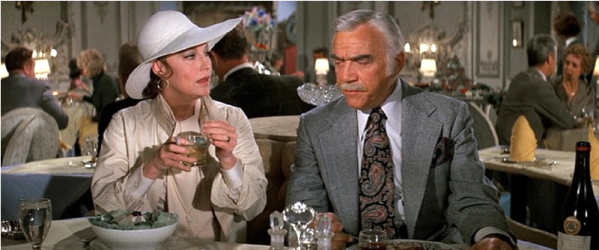
Lorne Greene was seven years older than his daughter.
